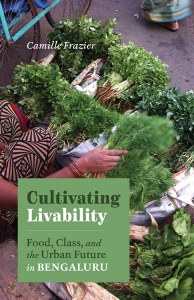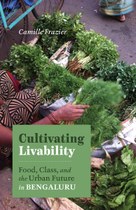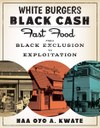Cultivating Livability
Food, Class, and the Urban Future in Bengaluru
Camille Frazier

What makes for a livable life, and for whom? Taking Bengaluru, India, as a case study, Camille Frazier probes the meaning of “livability” by exploring the food networks connecting peri-urban farmers and the middle-class public. Examining the varying efforts to reconfigure processes of food production, distribution, retail, and consumption, she demonstrates how these intersections are often rooted in and exacerbate ongoing forms of disenfranchisement that privilege some lives at the expense of others.
As the conditions of work and city living become increasingly precarious for millions across the globe, Camille Frazier illuminates a different set of future horizons for food systems. Beautifully written and clearly argued, Cultivating Livability analyzes the lives of tech workers in India who turn to farming and urban gardens, calling into question what makes life livable while building alternative possibilities.
Hanna Garth, author of Food in Cuba: The Pursuit of a Decent Meal
In recent years, the concept of “livability” has captured the global imagination, influencing discussions about the implications of climate change on human life and inspiring rankings of “most livable cities” in popular publications. But what really makes for a livable life, and for whom?
Cultivating Livability takes Bengaluru, India, as a case study—a city that is alternately described as India’s most and least livable megacity, where rapid transformation is undergirded by inequalities evident in the food networks connecting peri-urban farmers and the middle-class public. Anthropologist Camille Frazier probes the meaning of “livability” in Bengaluru through ethnographic work among producers and consumers, corporate intermediaries and urban information technology professionals.
Examining the varying efforts to reconfigure processes of food production, distribution, retail, and consumption, she demonstrates how these intersections are often rooted in and exacerbate ongoing forms of disenfranchisement that privilege some lives at the expense of others.
$28.00 paper ISBN 978-1-5179-1499-8
$112.00 cloth ISBN 978-1-5179-1498-1
224 pages, 18 b&w photos, 5 1/2 x 8 1/2, May 2024

Camille Frazier is the Agricultural Land Equity Program Lead at the California Strategic Growth Council within the Governor’s Office of Planning and Research.

As the conditions of work and city living become increasingly precarious for millions across the globe, Camille Frazier illuminates a different set of future horizons for food systems. Beautifully written and clearly argued, Cultivating Livability analyzes the lives of tech workers in India who turn to farming and urban gardens, calling into question what makes life livable while building alternative possibilities.
Hanna Garth, author of Food in Cuba: The Pursuit of a Decent Meal
In this thoughtful and compelling book, Camille Frazier outlines the central significance of food in contemporary struggles to forge a livable world. Grounded in vivid encounters with farmers, consumers, merchants, and environmentalists on Bengaluru’s rapidly changing periphery, Cultivating Livability traces the dilemmas and contradictions of a breakneck development—and the challenge of redefining what it means to live well.
Anand Pandian, coauthor of Ayya's Accounts: A Ledger of Hope in Modern India

Contents








